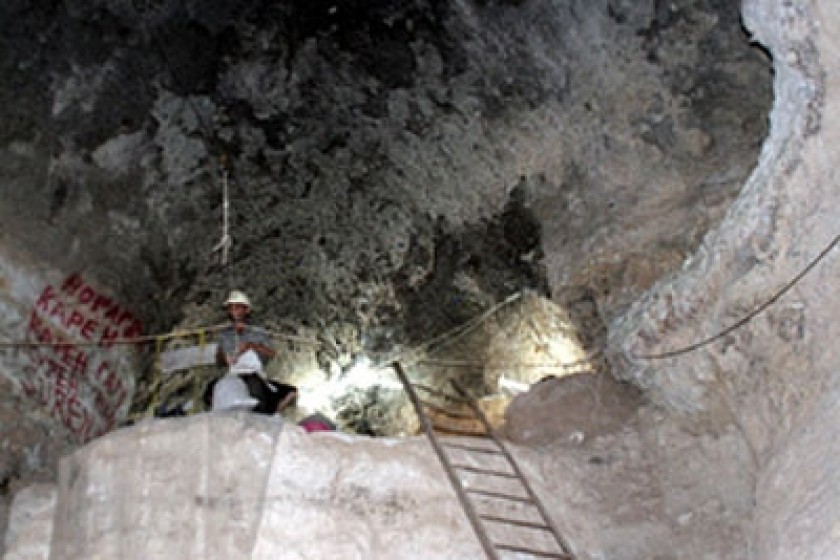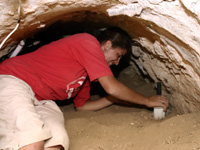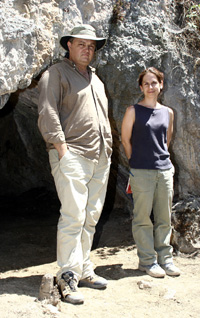
Prehistoric Site in Karabakh
In the 1970s, Azerbaijani scientists announced to the world that the site of a prehistoric human settlement and the bones of prehistoric man had been found in the village of Azikh, located in the region of Fizuli. The items and bones found were moved to Baku and have been kept at a museum there ever since. In reality, these reports referred to the village of Azokh in the Hadrut region of Mountainous Karabakh. The Azerbaijani scientists had used explosive substances during the excavations, and signs of explosions remain at the mouth of the cave to this day. Azokh has appeared a number of times throughout Armenian history. During different wars, the residents of nearby villages sought shelter in the cave there. Stories about this cave were passed down orally from generation to generation; village elders today tell stories about the cave that they heard from their grandfathers.
Excavation by an international team has been underway at the Azokh cave for five years now. The team, headed by British citizen Tanya King-Hovsepyan, works for one month each summer.
“This is a very important site for the Caucasus – important for archeology and anthropology. We hope to find the bones of prehistoric man here, since we've already discovered signs of his existence, tools and other evidence,” said Tanya King-Hovsepyan.
 Scientists have discovered a number of items over the past five years, proving that Neanderthal man used to live in the cave. The Armenian group within the team is led by anthropologist and doctor of science Levon Yepiskoposyan.
Scientists have discovered a number of items over the past five years, proving that Neanderthal man used to live in the cave. The Armenian group within the team is led by anthropologist and doctor of science Levon Yepiskoposyan.
“The large number of items discovered are proof that Neanderthals used to live here. They range from the smallest items to the largest – a five meter depiction of a bear living in the cave, which is – just imagine – 250 thousand years old,” Yepiskoposyan said.
The archeological group includes renowned scientists from Great Britain, Ireland, Spain, and Armenia as well as students from Karabakh. During our visit there was a lot of activity going on both inside and outside the cave. One group was digging soil, the other removing it, a third group was taking measurements, and a fourth was conducting laboratory studies in Azokh.
“When humans moved out of Africa and came to the Caucasus, they split into two directions here – one group moved towards Europe and the other towards Asia. This site in the Caucasus is very important because it helps us to understand that period. By studying the cave in Azokh we can gather information on a period which has remained largely unknown,” said Spanish scientist Patricio Dominguez.
 Two students from the department of history at the Artsakh State University are also part of the group. “This is the fourth year that I've been in this program and have been a member of this archeological group. This has been a great experience for me and a wonderful opportunity to learn,” said student Lena Asryan. Lena has decided to continue her education – stone tools are her area of interest, and she plans to specialize in that field.
Two students from the department of history at the Artsakh State University are also part of the group. “This is the fourth year that I've been in this program and have been a member of this archeological group. This has been a great experience for me and a wonderful opportunity to learn,” said student Lena Asryan. Lena has decided to continue her education – stone tools are her area of interest, and she plans to specialize in that field.
All the tools and bones are taken out of the cave in sacks. After a preliminary examination, the sand is washed off in the river and the items are taken to the laboratory. “All the information about the findings is entered into a computer and a database is created,” said Patricio Dominguez. The findings are transported to London, studied, and then preserved so that they do not decay. They are then returned to Karabakh and handed over to the Stepanakert museum.
Around twenty young people from Azokh are also part of the excavation work. “Over the past five years we've made a lot of friends in the village; the villagers support us. There are many people from the village who work with us, help us and participate in the excavation work,” King-Hovsepyan said.
 The scientists believe that the Azokh cave will claim its place in science. “Azokh is a unique cave in that it can tell the story of human history from prehistoric times up to today. To be more picturesque, it can be compared to a thick book with pages that are difficult to open. It is difficult to read those pages, and for that you need knowledge and certain skills. But in the end it allows you to discover and understand history which spans hundreds of thousands of years,” said Levon Yepiskoposyan excitedly.
The scientists believe that the Azokh cave will claim its place in science. “Azokh is a unique cave in that it can tell the story of human history from prehistoric times up to today. To be more picturesque, it can be compared to a thick book with pages that are difficult to open. It is difficult to read those pages, and for that you need knowledge and certain skills. But in the end it allows you to discover and understand history which spans hundreds of thousands of years,” said Levon Yepiskoposyan excitedly.
Team members seek sponsorship throughout the rest of the year, so that they can return to the site the following summer. They have difficulties sometimes because the excavations are in a country not recognized by the rest of the world – Karabakh. Another reason for the difficulties is that the Azerbaijanis periodically protest that the excavation is organized without consent from Baku.
When asked how long the excavation will last the Armenian group leader answered, “It would be more correct to ask, ‘How many generations will work here?' Many generations.” The team excitedly awaits the day they will make their biggest discovery – the bones of prehistoric man.
“That will be a discovery which will attract the attention of the whole world, not just of specialists,” said Levon Yepiskoposyan. The scientists are convinced that that would also help to promote scientific tourism. They have had the idea of constructing a museum at Azokh. People would come to Karabakh to see the abode of prehistoric man and all the pages of history summarized in the Azokh cave.
Tigran Baghdasaryan
4th year student, European Regional Academy
 Videos
Videos Photos
Photos
Write a comment